The use of postage stamps to pay telegraph charges.
- Australia 1901-1988
- New South Wales
- Overview of NSW
- Telegraph lines
- Telegraph Offices
- Date stamps
- Forms
- Envelopes
- Instructional annotation
- Collect
- Delayed
- Free
- Immediate Urgent
- Reply paid
- Rates
- Stamps
- 1871 Telegraph stamps
- 1885 proposal
- 1893 proposal
- Queensland
- South Australia
- Tasmania
- Victoria
- Western Australia
- International
- Special aspects
On this page:
- Official statement for use of stamps for prepayment of telegrams;
- the 1902 - 1911 issue for general use including to pre-pay telegram costs.
- Some stories about malpractice.
South Australian rates for sending telegrams before 1902 and Australian rates for sending telegrams after Federation are included elsewhere.
PAYMENT FOR TELEGRAMS.Adelaide Advertiser, 21 June 1902.
"South Australians dispatching telegrams will have to accustom themselves to an entirely new departure after June 30. Instead of tendering money as payment for a telegram, the sender must affix postage stamps to the form. This is the practice in Victoria and New South Wales and the Federal Postmaster-General has decided to apply the system to all the States. After the beginning of next month, stamps will be sold at the Adelaide Telegraph Office, the customer will affix the required number to his message, and the receiving officials will obliterate them at once".
Details of the 1885 New South Wales introduction of the practice of prepaying telegram costs with postage stamps is included elsewhere.
As only one format of a South Australian transmission form has been located, it is a matter of conjecture as to if and when postage stamps might have been used to pre-pay costs of sending a telegram. The close link between South Australia and New South Wales through E. C. Cracknell having been so closely associated with both Colonies leads to the hypothesis that stamps might have been used from 1885. No evidence of that possibility can be located.
A new issue with the same basic design was printed from 1902. The main design difference was the use of POSTAGE in the heading. The lettering was in thin letters until 1904 and then in thick letters. As Interim transmission forms were printed in this period which were consistent across the States, it is certain that these South Australian issues would have been used on transmission forms.
The 11 denominations ranged from 3d to £1.
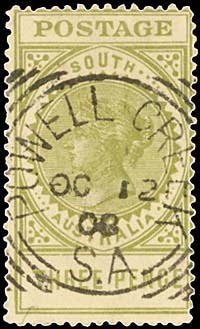 |
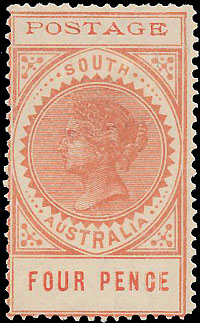 |
 |
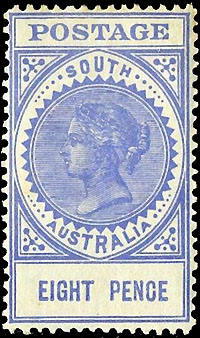 |
| 3d olive green. Powells Creek (NT). |
4d red-orange - thin letters. | 6d blue-green - thin letters. | 8d ultramarine. |
 |
 |
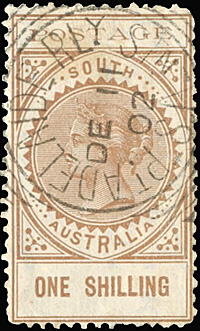 |
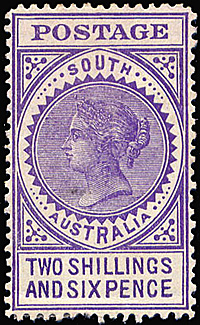 |
| 9d rose-lake - thick letters. | 10d dull yellow | 1/- brown - thin letters. Port Adelaide Railway Station 11 December 1902. Prestige Auctions Sale 177 Lot 716. |
2/6 pale-violet - thick letters. |
 |
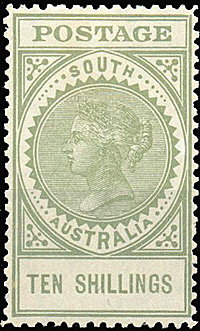 |
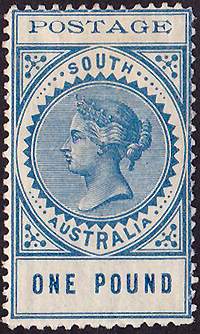 |
|
| 5/- rose - thick letters. | 10/- green - thick letters. | £1 blue - thin letters. |
Once stamps were used to pre-pay telegram costs, less-scrupulous employees saw the availability of stamps which remained in the telegraph offices as a source of extra income. Stories abound but one example for South Australia is:
The Advertiser 16 May 1932.
Stole Stamps Off Telegrams.
"Before Mr. W. V. Ray, S.M. in the Adelaide Police Court on Saturday Vincent Hector Rowe, postal officer, of Port Lincoln, was charged with having between January 3 and January 31 removed stamps from telegrams with fraudulent intent. Mr. E; J. Cook, postal Inspector, of Kadina, prosecuted, and Mr. J. L. Travers appeared for Rowe, who pleaded guilty. Mr. Cook said the total deficiency was £13 18/8. Rowe had been removing stamps from telegrams since between last July and March.
Mr. Ray said that without proceeding to a conviction, he would discharge Rowe conditionally on his entering into a bond of £20 and finding a surety for £20. to be of good behaviour for 12 months and to appear for sentence if called on within that time. Rowe would also have to make restitution to the Postal Department of the £13 18s 8d within six weeks".